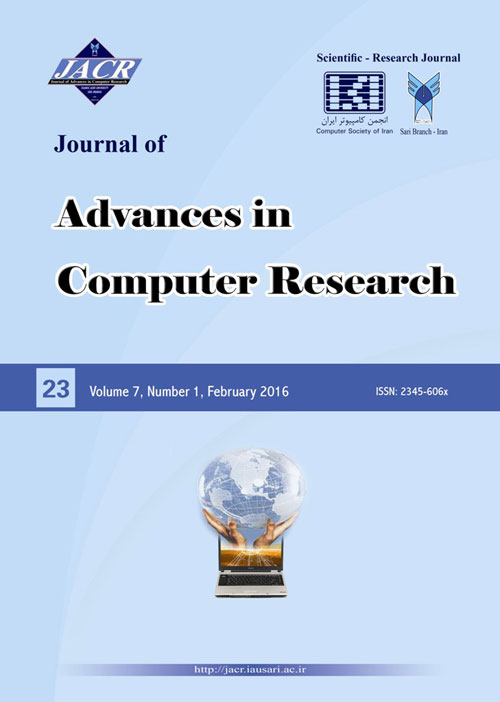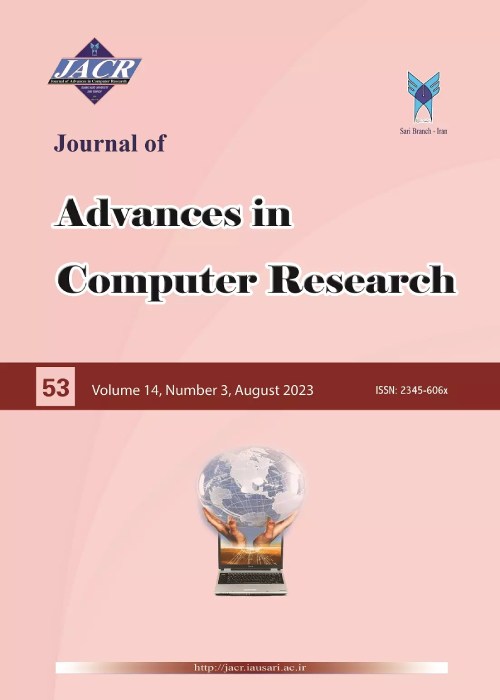فهرست مطالب

Journal of Advances in Computer Research
Volume:7 Issue: 1, Winter 2016
- تاریخ انتشار: 1394/12/05
- تعداد عناوین: 10
-
Pages 1-22The Capacitated Vehicle Routing Problem (CVRP) is a well-known combinatorial optimization problem that holds a central place in logistics management. The Vehicle Routing is an applied task in the industrial transportation for which an optimal solution will lead us to better services, save more time and ultimately increase in customer satisfaction. This problem is classified into NP-Hard problems and deterministic approaches will be time-consuming to solve it. In this paper, we focus on enhancing the capability of local search algorithms. We use six different meta-heuristic algorithms to solve VRP considering the limited carrying capacity and we analyze their performance on the standard datasets. Finally, we propose an improved genetic algorithm and use the ant colony algorithm to create the initial population. The experimental results show that using of heuristic local search algorithms to solve CVRP is suitable. The results are promising and we observe the proposed algorithm has the best performance among its counterparts.Keywords: Vehicle Routing Problem, Capacitated Vehicle Routing Problem, Meta, Heuristic Algorithms, Local Search, Genetic Algorithm
-
Pages 23-34Finding frequent patterns plays a key role in exploring association patterns, correlation, and many other interesting relationships that are applicable in TDB. Several association rule mining algorithms such as Apriori, FP-Growth, and Eclat have been proposed in the literature. FP-Growth algorithm construct a tree structure from transaction database and recursively traverse this tree to extract frequent patterns which satisfies the minimum support in a depth first search manner. Because of its high efficiency, several frequent pattern mining methods and algorithms have used FP-Growth’s depth first exploration idea to mine frequent patterns. These algorithms change the FP-tree structure to improve efficiency. In this paper, we propose a new frequent pattern mining algorithm based on FP-Growth idea which is using a bit matrix and a linked list structure to extract frequent patterns. The bit matrix transforms the dataset and prepares it to construct as a linked list which is used by our new FPBitLink Algorithm. Our performance study and experimental results show that this algorithm outperformed the former algorithms.Keywords: Association Rule Mining, Support, frequent pattern, FP, Growth Algorithm, itemset
-
Pages 35-48Premature ventricular contraction (PVC) is one of the common cardiac arrhythmias. The occurrence of PVC is dangerous in people who have recently undergone heart. A PVC beat can easily be diagnosed by a doctor based on the shape of the electrocardiogram signal. But in automatic detection, extracting several important features from each beat is required. In this paper, a method for automatic detection of PVC using adaptive neuro-fuzzy inference systems (ANFIS) is presented. In the proposed model first feature selection has been done using backward elimination algorithm, and then an ANFIS has been trained with selected attributes. The performance of the proposed method has been compared with two other methods. Simulation results show that the proposed algorithm, in addition to maintaining the classification accuracy compared to existing methods uses fewer features and requires less computing time, which is suitable for implementation on hardware with limited processing capability.Keywords: PVC, Neural Networks, Fuzzy Networks, ANFIS, Feature Selection
-
Pages 49-66Each license plate recognition system is composed of three main parts, namely, license plate detection, character segmentation and character recognition. In this paper, we focus on the improvement and innovation of the character recognition step. For this purpose, a new hierarchical architecture based on Support Vector Machines (SVMs) is suggested for Persian license plate characters recognition. Clustering characters in the hierarchical architecture is proposed based on a new criterion using a confusion matrix. The criterion and the confusion matrix have not been used for clustering in this way. The hierarchical architecture precision is 97/4% and recognizes the entire characters of a license plate in approximately 60ms. All evaluations and comparisons among the performances of previous methods and the proposed method in this paper have been done in the same hardware and software test bed. The dataset obtained from images in real conditions such as, day, night, different distances and angles.Keywords: License Plate Recognition, Persian Character Recognition, Hierarchical Architecture, Support Vector Machine
-
Pages 67-87Association rules are among important techniques in data mining which are used for extracting hidden patterns and knowledge in large volumes of data. Association rules help individuals and organizations take strategic decisions and improve their business processes. Extracted association rules from a database contain important and confidential information that if published, the privacy of individuals may be threatened. Therefore, the process of hiding sensitive association rules should be performed prior to sharing the database. This is done through changing the database transactions. These changes must be made in such a way that all sensitive association rules are hidden and a maximum number of non-sensitive association rules are extractable from the sanitized database. In fact, a balance is to be established between hiding the sensitive rules and extracting the non-sensitive rules. A new algorithm is presented in this paper to create a balance between preserving privacy and extracting knowledge. The items of sensitive rules are clustered in the proposed algorithm, in order to reduce changes. In fact, reduction of changes and clustering of rules are applied in order to reduce the side effects of the hiding process on non-sensitive rules.Keywords: Data Mining, Association Rules, Frequent Item, sets, Privacy Preserving Data Mining, Clustering
-
Pages 89-100Process mining includes the automated discovery of Petri nets from event logs. These event logs are the starting point for various discovery and analysis techniques of the process. In this paper process model is developed using colored Petri nets (CPNs) and the supporting software package CPN Tools. The restaurant process model is represented for the analysis using a combination of process mining and simulation. The goal of process mining is deducing knowledge (e.g. a process model, average throughput time) from event logs. The knowledge obtained this way can increase understanding of the processes and can help with redesigning them if needed. The bottlenecks can be detected with Process mining. We evaluate the indicators performance, such as throughput time, for different alternative process. Analysis results show that that what type of changes may be beneficial.Keywords: Business process, Colored Petri nets, Performance analysis, Process mining, Bottlenecks
-
Pages 101-116Proper operations of transformer have several issues such as; preventing of unscheduled removal’s, increasing of reliability and continues supply of consumer demand. This result would be obtained that load and harmonic orders of sensitivity transformer at intervals appropriate for next hours and days is predicted to by selecting optimal utilization coefficient, reduction life of transformer is prevented. A possible solution for load and harmonic orders forecasting is implementation of heuristically algorithm and method such as Artificial Neural Network (ANN). In this paper, firstly relationship between transformer loss and life and effect of harmonic on its, is evaluated. Then by ANN method, load and harmonic orders of 400KVA distribution transformer is predicted. Then by using of existing standards and programs written in MATLAB environment, Load ability or optimal utilization coefficient and life of transformer is calculated.Keywords: Artificial Neural Network. Transformer Loss, Life, Load Ability, Harmonic Orders
-
Pages 117-130Human action recognition is an important problem in computer vision. One of the methods that are recently used is sparse coding. Conventional sparse coding algorithms learn dictionaries and codes in an unsupervised manner and neglect class information that is available in the training set. But in this paper for solving this problem, we use a discriminative sparse code based on multi-manifolds. We divide labeled data samples into multi-manifolds and also to decrease run time, reduce dimension of manifolds. We find k inter nearest neighbors and intra nearest neighbors for each data sample in each manifold. The intra class variance should be minimized while the inter class variance should be maximized, in the result we could calculate laplacian matrix and optimize sparse code and dictionary. Then we use discriminative sparse error for classification. We run this method on KTH and UCF sport datasets. Results show that we obtain a better result (about 89%) in UCF dataset.Keywords: Action recognition, Discriminative Sparse Representation, Multi Manifold, Spatio, Temporal descriptors, Neighborhood
-
Pages 131-140Ultrasound images suffer of multiplicative noise named speckle. Different de-speckling algorithms run either in spatial domain or in transformed domain. In this paper, an adaptive filter in spatial domain according to assume the Nakagami distribution as the statistic of log-compressed ultrasound images is used. For de-speckling in transformed domain, the non-sub sampled shearlet transform is used. In addition, the Bayesian shrinkage as a well-known method for finding the optimum threshold values in transformed domain is applied. The main contribution of this paper is comparing the performance of two methods that suppress the speckle noise in spatial domain and transformed domain. For this purpose, a synthetic test image and the original ultrasound images are processed and peak signal to noise ratio (PSNR), mean square error (MSE), structural similarity (SSIM), edge keeping index (EKF), noise variance (NV), mean square difference (MSD), and equivalent number of looks (ENL) are obtained.Keywords: Nakagami distribution, adaptive filter, non sub, sampled shearlet transform, ultrasound image de, speckling, Bayesian shrinkage thresholding
-
Pages 143-156Due to the complex physical properties of the detected targets using sonar systems, identification and classification of the actual targets is among the most difficult and complex issues of this field. Considering the characteristics of the detected targets and unique capabilities of the intelligent methods in classification of their dataset, these methods seem to be the proper choice for the task. In recent years, neural networks and support vector machines are widely used in this field. Linear methods cannot be applied on sonar datasets because of the existence of higher dimensions in input area, therefore, this paper aims to classify such datasets by a method called Online Multi Kernel Classification (OMKC). This method uses a pool of predetermined kernels in which the selected kernels through a defined algorithm are combined with predetermined weights which are also updated simultaneously using another algorithm. Since the sonar data is associated with higher dimensions and network complexity, this method has presented maximum classification accuracy of 97.05 percent. By reducing the size of input data using genetic algorithm (feature selection) and statistical moments (feature extraction), eliminating the existing redundancy is crucial; so that the classification accuracy of the algorithm is increased on average by 2% and execution time of the algorithm is declined by 0.1014 second at best.Keywords: Sonar, Classification, OMKC, Genetic Algorithm, Statistical Moments, Clutter


